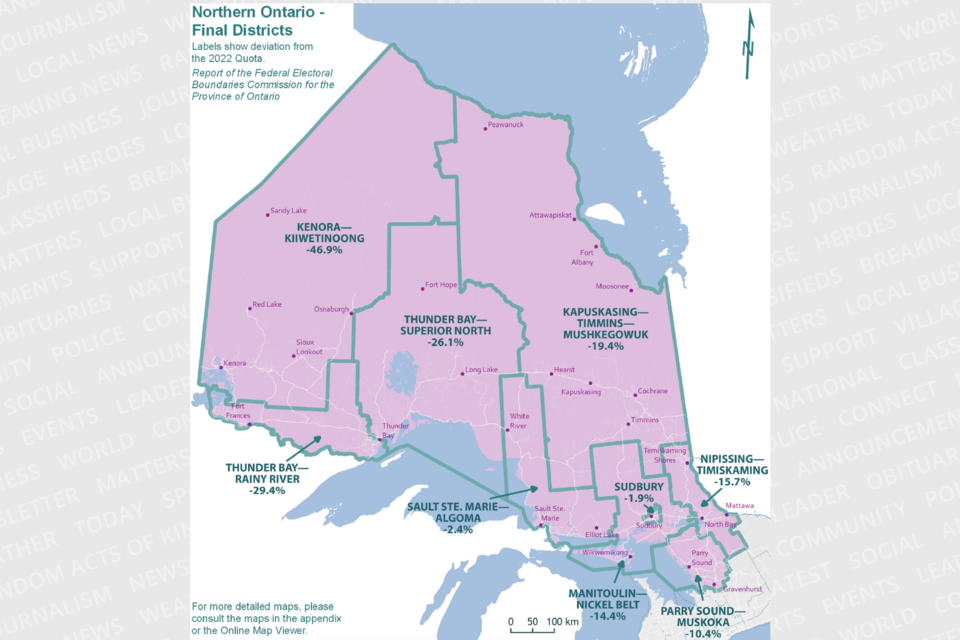The group tasked with adding one federal electoral district in Ontario is still proposing reducing the number of representatives in Northern Ontario, though it's redrawn how it thinks the region should be divided.
The Ontario Federal Electoral Boundary Commission has submitted its updated report to the House of Commons. Using feedback garnered during the public feedback, it's backtracked on creating a massive riding in the Far North.
The report also says that Parliament needs to take further action to "ensure effective representation of Indigenous Peoples — especially in the Far North."
One federal riding is being added to Ontario, bringing the total number to 122.
The updated report proposes removing one Member of Parliament (MP) in Northern Ontario and the City of Toronto. An MP would be added in the regions of Central Ontario; Brampton, Caledon, Dufferin; and Halton, Guelph, Wellington.
The proposed Kapuskasing-Timmins-Mushkegowuk riding would have a population of 93,948.
It includes Timmins, Cochrane, Hearst, Iroquois Falls, Kapuskasing, Kirkland Lake, Moosonee, Smooth Rock Falls, Black River-Matheson, Chapleau, Fauquier-Strickland, Gauthier, Larder Lake, Matachewan, Mattice-Val Côté, McGarry, Moonbeam, Opasatika, and Val Rita-Harty. The First Nations communities included are Abitibi, Attawapiskat, Chapleau No. 74A and 75, Chapleau Cree Fox Lake, Constance Lake, Duck Lake, Factory Island, Flying Post, Fort Albany, Matachewan, Moose Factory, New Post and Peawanuck.
In the north, the commission saw the potential to reduce two MPs seats. It opted to go with eliminating one district because a further reduction "would imperil the principle of effective representation in this part of the province, considering its widely dispersed population and communities of interest."
The commission says its final redistribution plan creates "manageable" geographic districts.
"It better respects transportation networks, especially flight networks to remote fly-in communities. It better aligns the communities with Tribal Councils. This plan also protects Franco-Ontarian communities of interest," reads the report.
As much as possible, the new boundaries also align with regional boundaries that are important to district services (such as the District Social Services Administration Boards).
"Finally, while it was not possible in this plan to create a district with a majority Indigenous population, the two geographically large districts referenced above each have significant northern Indigenous populations, which helps to ensure that Indigenous interests are not diluted and creates the potential for the election of Indigenous candidates," reads the report.
The original proposal unveiled in August 2022 "generated considerable public interest, input and criticism."
SEE: Proposed riding boundary changes a 'kick in the teeth': MP
To have more representatives in the North, the commission says Ontario would need to have more seats assigned and there would need to be a different formula applied to the northern regions.
"All of these alternatives are in the hands of Parliament," reads the report.
The commission says it considered other layouts for the north and looked at maintaining 10 seats by eliminating a representative from another region.
"In the commission's view, this would not be consistent with the broader and principal goal of assuring population equality between constituencies, while ensuring effective representation," they wrote.
Francophone concerns also played a factor in the decision.
The proposed new Timmins riding will be more francophone than before.
In Timmins-James Bay, 26 per cent of residents' first language is French, while it's 35 per cent for the new area, according to the report.
Work on the redistribution started in February 2022 with public input being submitted to the commission. The proposed redistribution was delivered to Elections Canada in June 2022, with the detailed maps published in August. In-person and virtual consultations were held in the fall, including one in Timmins.
Now that the report has been submitted, the next step is for objections from MPs, which is open from now until May. The commission will consider thos objections until May and the final representation order is expected in September.
